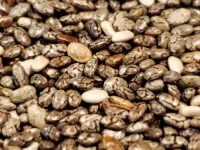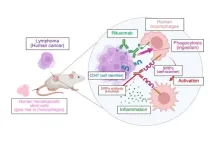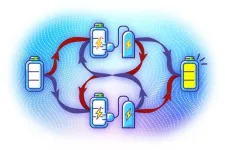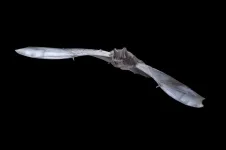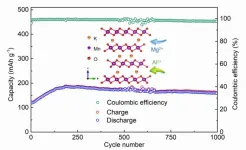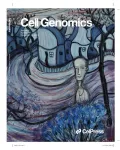(Press-News.org) If you thought blurry eyes were to blame for the “beer goggles” phenomenon, think again.
Scientists from the University of Portsmouth have tested the popular theory that people are more likely to find someone attractive while drunk, because their faces appear more symmetrical.
The term “beer goggles” has been used for decades to describe when a person finds themselves sexually attracted to someone while intoxicated, but not sober.
One possible explanation for the effect is that alcohol impairs the drinker’s ability to detect facial asymmetry, thus making potential partners more visually appealing.
Existing research has shown that a part of what makes people attractive to others is how well both sides of their face match. The thinking goes, the more symmetry the better the gene pool. But when alcohol is introduced, it’s thought a person is less likely to notice if the faces around them are non-symmetrical.
However, a new experiment found that while alcohol did impair face symmetry detection, it had no influence on facial attractiveness judgements.
Dr Alistair Harvey from the University of Portsmouth’s Department of Psychology, said: “Alcohol is a strong predictor of sexual behaviour, often consumed before or during dates.
“There are a range of possible reasons why alcohol drinkers are more inclined to engage in sex, including a lack of inhibition, heightened expectations, personality traits, and the beer goggles effect.
“Due to the limited research on this topic, we ran a field experiment to help determine why people often experience unexpected – and regretted – sexual escapades after having one too many.”
To gather the results, the team visited a local pub in the Portsmouth area. 99 men and women volunteered for the study, ranging in age from 18 to 62 years old.
They were asked to rate 18 individual faces for attractiveness and symmetry. Each type of rating was given twice, once for faces showing an enhanced asymmetry, and again for the same faces in their natural form. Participants then judged which of two same-face versions (one normal, the other perfectly symmetrised) was more attractive and, in the final task, more symmetrical.
The study used a robust procedure, taking ratings of individual faces in addition to the usual binary approach where participants select the more attractive or symmetrical face in a pair.
As predicted, heavily intoxicated individuals were less able to distinguish natural from perfectly symmetrised faces than more sober drinkers. But the more drunk viewers did not rate the faces as being any more attractive.
As expected, both male and female participants rated natural faces as being more attractive than the ones which were doctored to look wonky. But, surprisingly, this bias was stronger among women.
The paper, published in the Journal of Psychopharmacology, says one possible explanation to the findings could be that attractiveness depends on many factors that simply swamp the small effects of face symmetry.
“We don’t deny the existence of a “beer goggles” effect”, added Dr Harvey.
“But we suspect it would be more easily detectable when using live models for an experiment, instead of static photographs. Images conceal a range of important visual criteria for attractiveness, including build, body shape, height, expression, and clothing.
“Therefore, further research is needed to find the missing piece to the puzzle.”
END
Facial symmetry doesn’t explain “beer goggles”
A new study has tested the hypothesis that people are more likely to find someone attractive while drunk, because their face appears more symmetrical
2023-12-14
ELSE PRESS RELEASES FROM THIS DATE:
New study eyes nutrition-rich chia seed for potential to improve human health
2023-12-14
CORVALLIS, Ore. – Oregon State University scientists have sequenced the chia genome and in doing so provided a blueprint for future research that capitalizes on the nutritional and human health benefits of the plant.
In the just-published paper, the researchers identified chia genes associated with improving nutrition and sought after properties for pharmaceuticals that could be used to treat everything from cancer to high blood pressure. The seeds of the chia plant have received widespread attention in recent years because of the nutritional punch they pack.
Others have sequenced the chia genome, but this paper provides a more detailed look at the molecular ...
Were Neanderthals morning people ?
2023-12-14
A new paper in Genome Biology and Evolution, published by Oxford University Press, finds that genetic material from Neanderthal ancestors may have contributed to the propensity of some people today to be “early risers,” the sort of people who are more comfortable getting up and going to bed earlier.
All anatomically modern humans trace their origin to Africa around 300 thousand years ago, where environmental factors shaped many of their biological features. Approximately seventy-thousand years ago, the ancestors ...
Mice with humanized immune systems to test cancer immunotherapies
2023-12-14
Mice with human immune cells are a new way of testing anti-cancer drugs targeting the immune system in pre-clinical studies. Using their new model, the Kobe University research team successfully tested a new therapeutic approach that blindfolds immune cells to the body’s self-recognition system and so makes them attack tumor cells.
Cancer cells display structures on their surface that identify them as part of the self and thus prevent them from being ingested by macrophages, a type of immune cell. Cancer immunotherapy aims at disrupting these recognition systems. Previous studies showed that a substance that blinds macrophages to one of ...
Quantum batteries break causality
2023-12-14
Batteries that exploit quantum phenomena to gain, distribute and store power promise to surpass the abilities and usefulness of conventional chemical batteries in certain low-power applications. For the first time, researchers including those from the University of Tokyo take advantage of an unintuitive quantum process that disregards the conventional notion of causality to improve the performance of so-called quantum batteries, bringing this future technology a little closer to reality.
When you hear the word “quantum,” the physics governing the subatomic world, developments in ...
Mothers and children have their birthday in the same month more often than you’d think – and here’s why
2023-12-14
Do you celebrate your birthday in the same month as your mum? If so, you are not alone. The phenomenon occurs more commonly than expected – a new study of millions of families has revealed.
Siblings also tend to share month of birth with each other, as do children and fathers, the analysis of 12 years’ worth of data shows, whilst parents are also born in the same month as one another more often than would be predicted.
Previous research has found that women’s season of ...
Bats declined as Britain felled trees for colonial shipbuilding
2023-12-14
Bat numbers declined as Britain’s trees were felled for shipbuilding in the early colonial period, new research shows.
The study, by the University of Exeter and the Bat Conservation Trust (BCT), found Britain’s Western barbastelle bat populations have dropped by 99% over several hundred years.
Animals’ DNA can be analysed to discover a “signature” of the past, including periods when populations declined, leading to more inbreeding and less genetic diversity.
Scientists used this method to discover the historic decline ...
Guest pre-intercalation: an effective strategy to boost multivalent ion storage
2023-12-14
Due to the merits of low cost, low installation requirements, and high-level safety, aqueous rechargeable batteries (ARBs) offer an ideal option for dealing with future energy-demand pressure. Traditional aqueous batteries are mostly concentrated on mono-valent metal-ion, such as Li+, Na+, and K+. Compared to mono-valent carriers, multivalent cations have the capability to transfer more than one electron, and thereby to potentially provide better energy storage. To date, aqueous multivalent ion batteries based on Zn2+ have received a lot of attention. However, the investigations on aqueous ...
Unravelling the association between neonatal proteins and adult health
2023-12-14
Research led by Professor John McGrath from the University of Queensland found that the concentration of the C4 protein, an important part of the immune system, was not associated with risk of mental disorders.
However, the research also showed that a higher concentration of the C3 protein reduces the risk of schizophrenia in women, and studies based on the genetic correlates of C4 found strong links with several autoimmune disorders.
Professor John McGrath from UQ’s Queensland Brain Institute said his colleagues at Aarhus University in Denmark looked at ...
Gut bacteria of malnourished children benefit from key elements in therapeutic food
2023-12-14
A clinical trial reported in 2021 and conducted by a team of researchers from Washington University School of Medicine in St. Louis and the International Centre for Diarrhoeal Disease Research in Dhaka, Bangladesh, showed that a newly designed therapeutic food aimed at repairing malnourished children’s underdeveloped gut microbiomes was superior to a widely used standard therapeutic food.
Now, another study from the same research team at Washington University School of Medicine has identified key, naturally occurring biochemical components of this new therapeutic food and the important bacterial strains that process these ...
Gayle Benson makes historic donation for new home for Ochsner Children’s Hospital
2023-12-14
NEW ORLEANS, La. – Ochsner Health announces plans for The Gayle and Tom Benson Ochsner Children’s Hospital, made possible through a transformational gift from Mrs. Gayle Benson.
“We are proud to unveil much-anticipated plans for a new home for Louisiana’s No. 1 ranked children’s hospital,” said Pete November, CEO, Ochsner Health. “Ochsner is deeply grateful for Mrs. Benson and her unparalleled act of generosity, which will significantly impact the lives of countless families throughout Louisiana and the Gulf South. This facility will enable us to care for more children, retain and attract top pediatric physicians ...
LAST 30 PRESS RELEASES:
Air pollution exposure and birth weight
Obstructive sleep apnea risk and mental health conditions among older adults
How talking slows eye movements behind the wheel
The Ceramic Society of Japan’s Oxoate Ceramics Research Association launches new international book project
Heart-brain connection: international study reveals the role of the vagus nerve in keeping the heart young
Researchers identify Rb1 as a predictive biomarker for a new therapeutic strategy in some breast cancers
Survey reveals ethical gaps slowing AI adoption in pediatric surgery
Stimulant ADHD medications work differently than thought
AI overestimates how smart people are, according to HSE economists
HSE researchers create genome-wide map of quadruplexes
Scientists boost cell "powerhouses" to burn more calories
Automatic label checking: The missing step in making reliable medical AI
Low daily alcohol intake linked to 50% heightened mouth cancer risk in India
American Meteorological Society announces Rick Spinrad as 2026 President-Elect
Biomass-based carbon capture spotlighted in newly released global climate webinar recording
Illuminating invisible nano pollutants: advanced bioimaging tracks the full journey of emerging nanoscale contaminants in living systems
How does age affect recovery from spinal cord injury?
Novel AI tool offers prognosis for patients with head and neck cancer
Fathers’ microplastic exposure tied to their children’s metabolic problems
Research validates laboratory model for studying high-grade serous ovarian cancer
SIR 2026 delivers transformative breakthroughs in minimally invasive medicine to improve patient care
Stem Cell Reports most downloaded papers of 2025 highlight the breadth and impact of stem cell research
Oxford-led study estimates NHS spends around 3% of its primary and secondary care budget on the health impacts of heat and cold in England
A researcher’s long quest leads to a smart composite breakthrough
Urban wild bees act as “microbial sensors” of city health.
New study finds where you live affects recovery after a hip fracture
Forecasting the impact of fully automated vehicle adoption on US road traffic injuries
Alcohol-related hospitalizations from 2016 to 2022
Semaglutide and hospitalizations in patients with obesity and established cardiovascular disease
Researchers ‘listen in’ to embryo-mother interactions during implantation using a culture system replicating the womb lining
[Press-News.org] Facial symmetry doesn’t explain “beer goggles”A new study has tested the hypothesis that people are more likely to find someone attractive while drunk, because their face appears more symmetrical
